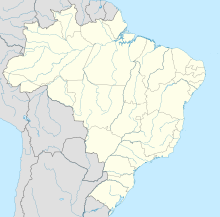
Minas Gerais is one of the 27 federative units of Brazil, being the fourth largest state by area and the second largest in number of inhabitants with a population of 20,539,989 according to the 2022 census. Located in the Southeast Region of the country, it is bordered to south and southwest by São Paulo; Mato Grosso do Sul to the west; Goiás and the Federal District to the northwest; Bahia to the north and northeast; Espírito Santo to the east; and Rio de Janeiro to the southeast. The state's capital and largest city, Belo Horizonte, is a major urban and finance center in Brazil, being the sixth most populous municipality in the country while its metropolitan area ranks as the third largest in Brazil with just over 5.8 million inhabitants, after those of São Paulo and Rio de Janeiro. Minas Gerais' territory is subdivided into 853 municipalities, the largest number among Brazilian states.

The Brazilian Highway System is a network of trunk roads administered by the Ministry of Transport of Brazil. It is constructed, managed and maintained by the National Department of Transport Infrastructure (DNIT), a federal agency linked to the Ministry of Infrastructure, and the public works departments of state governments.

Águas Formosas is a Brazilian municipality located in the north-east of the state of Minas Gerais. Its population as of 2020 was 19,247 living in a total area of 817 km2. The city belongs to the statistical mesoregion of Vale do Mucuri and to the statistical microregion of Nanuque. It became a municipality in 1938.
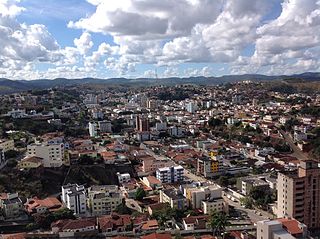
Teófilo Otoni is a municipality in northeast Minas Gerais, Brazil. The population of the municipality was 140,937 in 2020 and the area is 3,242.818 km2.

The Rodovia Anhanguera is a highway in the state of São Paulo, Brazil. It is one of the country's busiest transportation corridors. A 2005 survey conducted amongst Brazilian truck drivers rated it as the best transportation axis in the country. It is part of the federal highway called BR-050 that connects Brasilia to São Paulo, however, in the state of São Paulo it receives the name of SP-330.

Araçuaí is a Brazilian municipality located in the northeast of the state of Minas Gerais in the Jequitinhonha River valley. The Araçuaí River, a tributary of the Jequitinhonha, flows through it. Its population as of 2020 was estimated to be 36,712 people living in a total area of 2,235 km2. The city belongs to the mesoregion of Jequitinhonha and the microregion of Araçuaí. The city is the seat of the Roman Catholic Diocese of Araçuaí. The elevation of the municipal seat is 307 meters. It became a municipality in 1870.

Capelinha is a Brazilian municipality located in the north-center of the state of Minas Gerais. Its population as of 2020 was 38,057 living in a total area of 966 km². The city belongs to the statistical mesoregion of Jequitinhonha and to the statistical microregion of Capelinha. It became a municipality in 1913.

Itinga is a Brazilian municipality located in the northeast of the state of Minas Gerais in the Jequitinhonha River valley. As of 2020 the population was 15,022 in a total area of 1,641 km2. The city belongs to the mesoregion of Jequitinhonha and to the microregion of Araçuaí. The elevation of the municipal seat is 269 meters. It became a municipality in 1943. Between the municipalities of Araçuaí and Itinga is located the largest lithium mine in Brazil, explored and extracted by Sigma Lithium Resources.
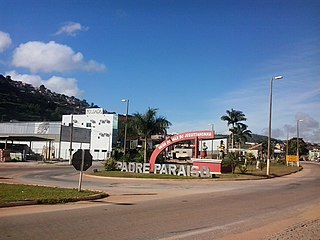
Padre Paraíso is a Brazilian municipality located in the northeast of the state of Minas Gerais. Its population as of 2020 was estimated to be 20,252 people living in a total area of 543 km2. The city belongs to the mesoregion of Jequitinhonha and to the microregion of Araçuaí. It became a municipality in 1962.
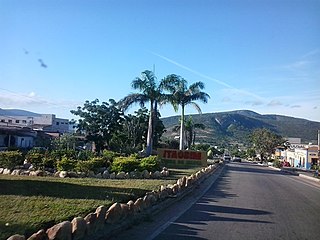
Itaobim is a municipality in the northeast of the Brazilian state of Minas Gerais. Its population in 2020 was 21,029 inhabitants in a total area of 680 km². It belongs to the Pedra Azul statistical microregion. The elevation of the municipal seat is 180 meters. It became a municipality in 1962. Neighboring municipalities are Medina, Jequitinhonha, Ponto dos Volantes and Itinga. The distance to the state capital, Belo Horizonte is 604 kilometers.
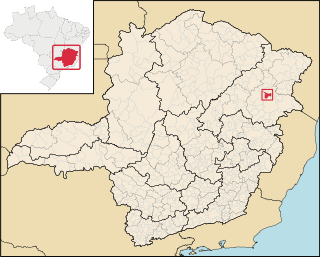
Catuji is a Brazilian municipality located in the northeast of the state of Minas Gerais. Its population as of 2020 was estimated to be 6,257 people living in a total area of 421 km2. The city belongs to the mesoregion of Vale do Mucuri and to the microregion of Teófilo Otoni. It became a municipality in 1993.

Campanário is a Brazilian municipality located in the northeast of the state of Minas Gerais. Its population as of 2020 was 3,730 people living in a total area of 441 km². The city belongs to the meso-region of Vale do Rio Doce and to the micro-region of Governador Valadares. It became a municipality in 1943.

BR-040 is a federal highway of Brazil. The 1,139.3 kilometres (707.9 mi) road connects Brasília to Rio de Janeiro.

BR-050 is a federal highway of Brazil. The 1025.3 kilometre road connects Brasília to Santos. Inside of São Paulo, the highway also receives the designation of Rodovia Anhanguera (SP-330).
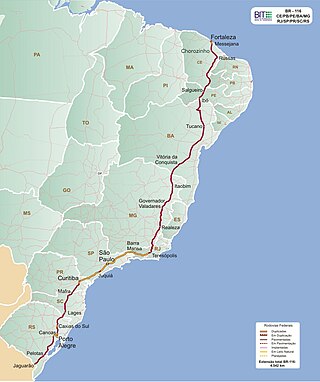
BR-116 is part of the Brazilian Highway System. With at total length of 4,542 km (2,822 mi) it is the longest highway in the country. It is also the longest highway in the country to be completely paved.

Events in the year 2000 in Brazil.

On 5 November 2021, a Beechcraft King Air on approach for landing to the Ubaporanga Airport in Piedade de Caratinga, near Caratinga, Brazil, crashed 4 kilometers from the runway, killing all five people on board, including singer-songwriter Marília Mendonça. The airplane involved belonged to PEC Aviation, a Brazilian air taxi operator.

Events in the year 2022 in Brazil.
The BR-267 is a Brazilian federal highway that crosses the Brazilian states of Minas Gerais, São Paulo and Mato Grosso do Sul.

The 2022–2023 Brazilian election protests began shortly after the conclusion of the 2022 Brazilian general election's second round on 30 October, in which Luiz Inácio Lula da Silva was elected president, which led to mass protests and roadblocks nationwide. Supporters of Jair Bolsonaro, who are frequently referred to in media accounts as Bolsonaristas, alleging election fraud, began blocking roads and highways in the country. At least 23 Brazilian states, plus the Federal District, recorded roadblocks as of 1 November, adding up to at least 267 roadblocks according to data from Federal Highway Police (PRF).


